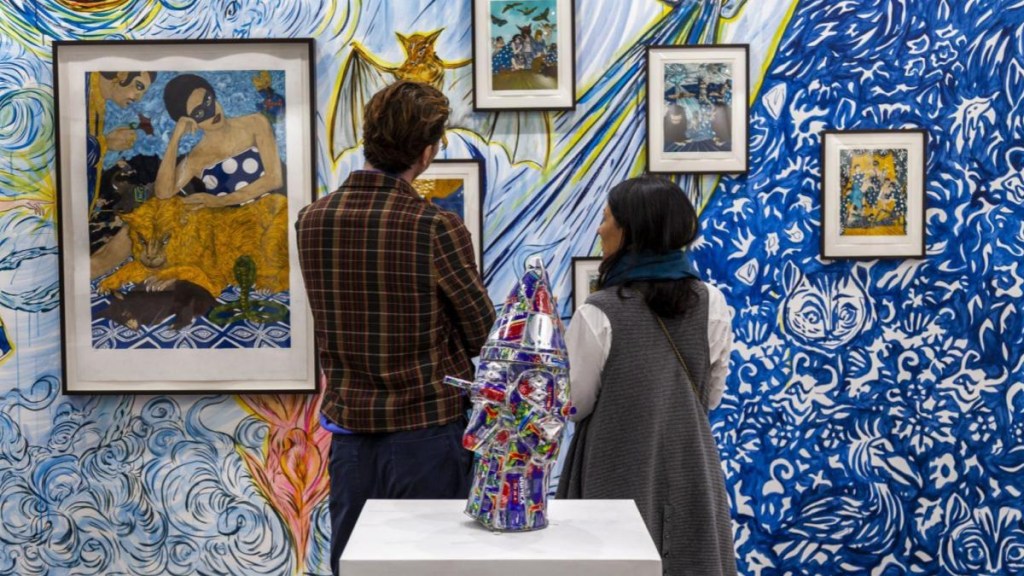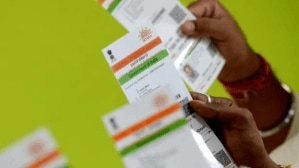Gunjan Gupta’s ‘MudaWala Throne’ is not just an innovative piece of collectible design. It represents the bicycle vendors of India who carry mobile shops on their backs, as well as a symbol of status and hierarchy in India. The ‘throne’ was made using recycled objects like cane stools (muda) on bicycle parts and wrapped in leather, redefining the concept of a ‘chair’ in India.
“The chair is seen as a throne and symbol of power. It also shows how the bicycle is way more than just a mode of transport—a vehicle for the family, a mobile shop and an object whose parts can be recycled to create new objects,” says the Delhi-based artist-designer.
“I use this symbolic value of the chair to tell stories that are subversive,” says Gupta, whose artworks are on display at the ongoing India Art Fair in New Delhi.
While Gupta feels design does not always need functionality, and that the boundaries between art and design, or any creative field for that matter, have never truly existed, creatives of all kinds have always been in conversation with each other.
“Art and interior design share a near-symbiotic relationship, with the two disciplines feeding off each other. While my ‘HER Totem Pole’ is made of a matka table that morphs into a series of four pots stacked on each other, typically like a totem pole, the ‘MudaWala Throne’ serves as a storytelling artefact—both are an elusive combination of functionality and aesthetics. Such functional art pieces narrate tales of everyday life of India— making them culturally significant and internationally relevant additions to luxury homes worldwide,” says Gupta, whose collective at the fair titled, ‘The Everyday Yesterday’, represents a fusion of craft and design with rich paradoxes of Indian culture.
Apart from Gupta, there are six other designers/studios at the newly introduced design space at the India Art Fair, showcasing their handmade collectibles. They are Vikram Goyal (New Delhi), Ashiesh Shah (Mumbai), Rooshad Shroff (Mumbai), Studio Renn (Mumbai), de Gournay (London / Paris / New York / San Francisco / Los Angeles / Beirut / Shanghai), and Karishma Swali & Chanakya School of Craft (Mumbai).
“South Asia has become a global design destination, and visitors and collectors are experiencing the full force of our design talent,” said Jaya Asokan, director, India Art Fair.
While designer Vikram Goyal’s brass and metal sculptures are design objects beyond the purely functional, Mumbai-based architect Rooshad Shroff brings limited-edition furniture made with marble inlays.
There is a conceptual installation titled ‘Water Matters’ by Franco-Cameroonian artist Barthelemy Toguo which depicts a 5-metre-long embroidery in cotton thread and 100-engraved bottles filled with water to reflect the ecological and societal concerns.
“Water is a priceless and vital element. I am very concerned about this resource, which should be a right for everyone, but which is cruelly lacking and endangering the living world, both human and animal. Realising the current problem of the lack of drinking water in many parts of Africa and the rest of the world, I wanted to focus my project with the Chanakya School of Craft in Mumbai on this issue,” shares Toguo, who has collaborated with the French Institute in India and creative director Karishma Swali, along with the artisans of Chanakya School of Craft, to create the masterpiece.
Most of Chanakya’s narratives are hand-embroidered in stem stitch, back stitch, and micro-French knots employed to achieve an ink spread similar to that found in paintings. The use of textiles made by master artisans combines fine jewels in handwoven silk, organza, khadi, jute and linen along with expressive jewellery. The artworks highlight the importance of local communities in safeguarding the richness and diversity of Indian traditions.
“Our artistic collaborations embody a collective vision, celebrating the fusion of art and craft to create a new language across various interdisciplinary mediums,” says Karishma Swali, creative director of Chanakya School of Craft.
Swali’s intricate interplay of hand-spun yarns and layering techniques features hand-moulded sculptures created with bamboo terracotta, papier-mâché, jute and basket weaving techniques, which are a tribute to the resilient and unyielding spirit of the feminine.








